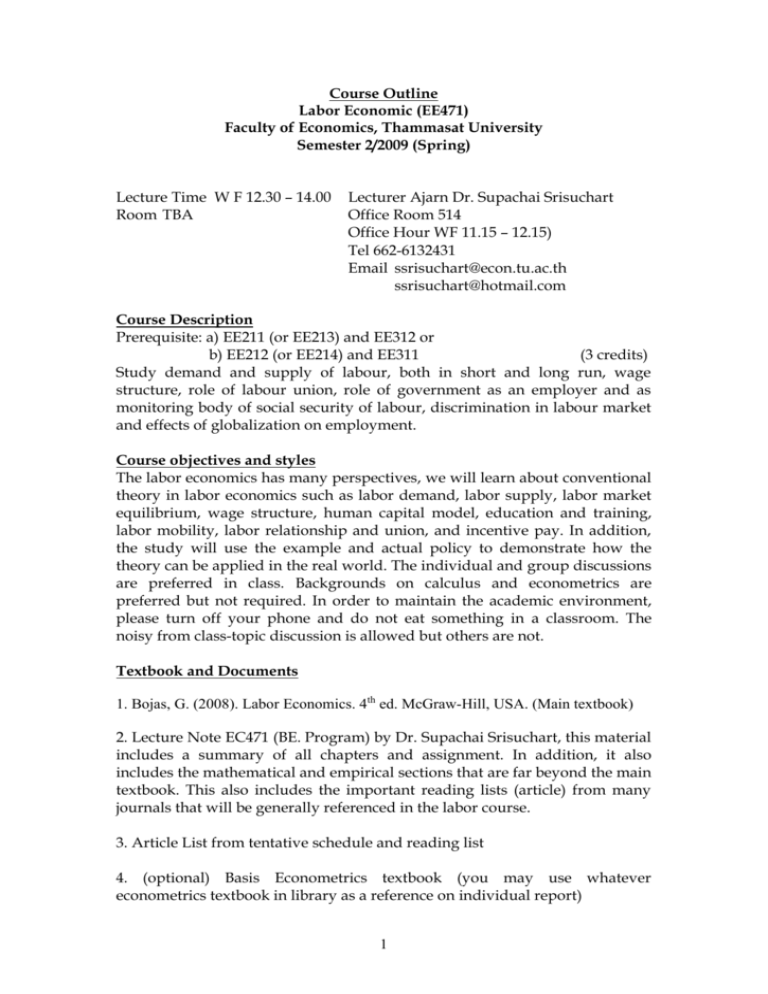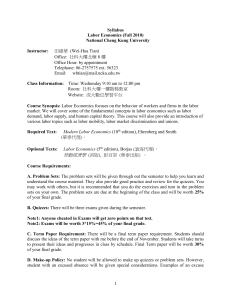Labor Economic (EE471) - Faculty of Economics
advertisement

Course Outline Labor Economic (EE471) Faculty of Economics, Thammasat University Semester 2/2009 (Spring) Lecture Time W F 12.30 – 14.00 Room TBA Lecturer Ajarn Dr. Supachai Srisuchart Office Room 514 Office Hour WF 11.15 – 12.15) Tel 662-6132431 Email ssrisuchart@econ.tu.ac.th ssrisuchart@hotmail.com Course Description Prerequisite: a) EE211 (or EE213) and EE312 or b) EE212 (or EE214) and EE311 (3 credits) Study demand and supply of labour, both in short and long run, wage structure, role of labour union, role of government as an employer and as monitoring body of social security of labour, discrimination in labour market and effects of globalization on employment. Course objectives and styles The labor economics has many perspectives, we will learn about conventional theory in labor economics such as labor demand, labor supply, labor market equilibrium, wage structure, human capital model, education and training, labor mobility, labor relationship and union, and incentive pay. In addition, the study will use the example and actual policy to demonstrate how the theory can be applied in the real world. The individual and group discussions are preferred in class. Backgrounds on calculus and econometrics are preferred but not required. In order to maintain the academic environment, please turn off your phone and do not eat something in a classroom. The noisy from class-topic discussion is allowed but others are not. Textbook and Documents 1. Bojas, G. (2008). Labor Economics. 4th ed. McGraw-Hill, USA. (Main textbook) 2. Lecture Note EC471 (BE. Program) by Dr. Supachai Srisuchart, this material includes a summary of all chapters and assignment. In addition, it also includes the mathematical and empirical sections that are far beyond the main textbook. This also includes the important reading lists (article) from many journals that will be generally referenced in the labor course. 3. Article List from tentative schedule and reading list 4. (optional) Basis Econometrics textbook (you may use whatever econometrics textbook in library as a reference on individual report) 1 5. (optional – graduated level) Bosworth. D., Dawkins P., and Stromback. (1996). The Economics of the Labour Market. Addison Wesley. 6. (optional – graduated level) Handbook of Labor Economics, there are in library (Book 1, 2, 3A, 3B, 3C) 7. (Optional) Campbell R. McConnel, Stanley L. Brue an David A. Macpherson. (1999 or later edition). Contemporary Labor Economics Evaluation 1. Midterm exam (Friday 5th March 2010, 12.30 – 14.00) 30% 2. Individual report (submit 1/2 week after final exam date which is 20th May 2010–no late than 14.00) 20% 3. Class quizzes and participation 10% th 4. Final Exam (Sunday 16 May 2010, 9.00 – 12.00) 40% Total 100% Note: Midterm and final exam dates are not changed due to the official schedule from BE program. Student who missed an exam cannot make up later, so these exams are student’s responsibility. The sentence “travel with family”, “Already reserved a ticket”, “forget the exam date”, “traffic jam” are invalid reason for postpone the exam. Only physical condition with approval medical document is allowed for postponing the exam. Class Quizzes There are 4 – 5 random quizzes which are counted for 10% of total score. In addition, I may drop the lowest score out of calculation. Student who missed a quiz cannot make up later, so these quizzes are student’s responsibility. The made up quiz may allow for student who had a physical condition with well medical document from doctor/hospital. The quiz is prepared from the class material that is learned in a class and reading list. Individual Report The individual report (if the class is larger than 40 students – I allowed for couple work) will be submitted half week after the final exam. The first draft will be submitted one week after the midterm exam. The report must be included cover (with title and your name), preface, chapters, which contain introduction, literature review, methodology (if applicable), data and source, analysis section or result, and summary (policy recommendation). Instructor does not specify the topic; you may select topics by yourselves. However, topic should be included in the context of labor economics and issues in class. The empirical study and theoretical study are equally preferred in terms of score judgment. Students who plan to apply the advanced technique/methodology must be getting a permission and guidance from the instructor. Example of Topics are international labor mobility, effect of FTA on local labor market, wage differential between 2 gender and race, workplace environment and compensation, social insurance, government pension fund, agricultural labor market, etc. The score will be based on completion of section, writing of literature review (linkage, significance, and grouping), methodology, and result of study with conclusion and policy implications. Copy and plagiarize are prohibited by faculty and program rule, so the score will be adjusted to zero for plagiarism or copy without appropriate citation and reference (see MLA or APA citation style). The examples of style are in website MLA Style: http://www.liu.edu/CWIS/CWP/library/workshop/citmla.htm APA Style: http://www.liu.edu/CWIS/CWP/library/workshop/citapa.htm Chicago Style: http://www.liu.edu/cwis/cwp/library/workshop/citchi.htm Important Days Class Begin Jan 4 Adding and Dropping Jan 4 – 18 Thailand University Sport Game* Thursday – Saturday 21-30 Midterm Exam Friday 5th March 2010, 12.30 – 14.00 (No lecture at 3rd March due to midterm week) Songkran Festival* Wednesday and Friday 14 and 16, April Class End May 4th, 2010 Final Exam Sunday 16th May 2010, 9.00 – 12.00 Note * is holiday 3 Tentative Schedule and reading list (*** is required reading) 1. Introduction to labor economics 1.1 Data in Labor market 1.2 Empirical strategies in labor economics Reading Lists: *** Bojas (Chapter 1) Angrist, Joshua, and Alan Krueger. "Empirical Strategies in Labor Economics." The Handbook of Labor Economics. Vol. 3A. 1999, chapter 23, sections 3 and 4, pp. 1278-1357. Deaton, Angus. 1997. The Analysis of Household Surveys, The Johns Hopkins University Press, Chapters 1 and 2 2. Labor Supply 2.1 Measuring Labor force and Thailand’s Data (NSO data) 2.2 Labor supply and Derivation 2.3 Family Decision on Labor supply and Life-Cycle Decision 2.4 Policy Application 2.5 Empirical Finding Reading Lists: *** Bojas (Chapter 2) ** Bosworth et al. (Chapter 5) Ashenfelter, Orley. "Macroeconomic and Microeconomic Analyses of Labor Supply." Carnegie-Rochester Conference on Public Policy 21 (1984): 117-156. Becker, Gary S. 1965. “A Theory of the Allocation of Time,” The Economic Journal, September, pp. 493-517. Chiappori, Pierre-Andre. 1992. “Collective Labor Supply and Welfare,” Journal of Political Economy, Vol. 100, No.3, pp.437-467. MaCurdy, Thomas. 1981. “An Empirical Model of Labor Supply in a Life-Cycle Setting,” Journal of Political Economy 89, pp. 1059-85. 4 3. Labor Demand 3.1 Short Run and Long Run Labor Demand 3.2 Substitution and Income Effect Analysis 3.3 Elasticity Analysis 3.4 Minimum Wage Reading Lists: *** Bojas (Chapter 3) ** Bosworth et al. (Chapter 8) Card, David, and Alan Kreuger. 1995. “Myth and Measurement: the New Economics of Minimum Wage”, selected chapters, (Princeton: Princeton University Press) Hamermesh, Daniel. "The Demand for Labor in the Long Run." Chapter 8 in Handbook of Labor Economics. Vol. 1. Amsterdam, Netherlands: North-Holland, 1986. Tito Boeri and Jan Van Ours (2008). The Economics of Imperfect Labor (Chapter 2 Minimum Wage). Princeton University Press. 4. Market Equilibrium 4.1 Equilibrium and Adjustment 4.2 Static and Dynamic Equilibrium 4.3 Market Structure 4.4 Policy Applications 4.5 Practical Wage Determination Reading Lists: *** Bojas (Chapter 4) ** Bosworth et al. (Chapter 12, 13, 14) R. McConnel, Stanley L. Brue an David A. Macpherson (Chapter 7) 5 5. Human Capital 5.1 Schooling and Human Capital Accumulation 5.2 Estimating return to school 5.4 Training 5.5 Present value concept 5.6 Life-time Earning 5.7 Policy Implication: Student Loan Program Reading Lists: *** Bojas (Chapter 6) Abraham, Katharine G., and Henry S. Farber. 1987. "Job Duration, Seniority, and Earnings," American Economic Review, 77(3), pp. 278-97. Altonji, Joseph, and J. Shakotko. 1987. "Do Wages Rise with Seniority?" Review of Economic Studies, LIV, pp. 437-59. Angrist, Joshua D., and Alan B. Krueger. 1991. "Does Compulsory School Attendance Affect Schooling and Earnings?" Quarterly Journal of Economics, CVI(4), p. 979-1014. Becker, Gary S. 1993. Human Capital, Chicago: University of Chicago Press, Chapters II, III, IV, and V (section 2). (Mostly from his original book of 1964 NBER) Bosworth et al. (Chapter 15, 16, 17) Card, David. 1999. “The Causal Effect of Education and Earnings,” Handbook 3A, Ch. 30. Card, David, and Alan B. Krueger. 1992. “Does School Quality Matter? Returns to Education and the Characteristics of Public Schools in the United States,” Journal of Political Economy 100: 1-40. Korenman, Sanders, and David Neumark. 1991. "Does Marriage Really Make Men More Productive?" Journal of Human Resources 26(2): 282-307. R. McConnel, Stanley L. Brue an David A. Macpherson (Chapter 9, 10) 6 6. Wage Structure and Wage Differential 6.1 Wage distribution and Inequality 6.2 Wage Structure 6.3 Risky and Low Risk Job 6.4 Theory of Compensation Wage 6.5 Policy Applications Reading Lists: *** Bojas (Chapter 7, 5) R. McConnel, Stanley L. Brue an David A. Macpherson (Chapter 8) 7. Labor Mobility 7.1 Family Migration 7.2 Job Search and Job Match 7.3 Turnovers and Profile 7.4 Inter and Intra Industry Mobility 7.5 Policy Applications Reading Lists: *** Bojas (Chapter 8) *Farber, Henry S. 1999. “Mobility and Stability: The Dynamics of Job Change in Labor Markets”, Handbook 3B, Ch. 37. *Farber, Henry S. 1994. “The Analysis of Interfirm Worker Mobility,” Journal of Labor Economics, Vol. 12 no. 4, pp. 554-93. *Topel, Robert H. and Michael P. Ward, 1992. “Job Mobility and the Careers of Young Men”, Quarterly Journal of Economics, vol. 107, 441-79. *Mortensen, D., and C. Pissarides. 1999. “New Developments in Models of Search in the Labor Market” Handbook 3B Chapter 39. 7 8. Labor Market Discrimination 8.1 Gender and Race Discrimination 8.2 Experimental and Empirical Studies 8.3 Policy Applications Reading Lists: *** Bojas (Chapter 9) Altonji, Joseph G. and Rebecca Blank. 1999. “Race and Gender in the Labor Market.” Handbook 3C. Ch. 48. *Becker, Gary S. 1971. The Economics of Discrimination (Chicago, IL: The University of Chicago Press), Chapters 1-5. *Bertrand, Marianne, and Sendhil Mullainathan. 2004. “Are Emily and Greg More Employable than Lakisha and Jamal?” American Economic Review 94(4): 991-1013. *Goldin, Claudia. and Cecila Rouse. 2000. “Orchestrating Impartiality: The Impact of "blind" Auditions on Female Musicians,” American Economic Review, 90:715-741. 9. Labor Unions 9.1 Efficient Bargaining 9.2 Strike and Wage Effect Reading Lists: *** Bojas (Chapter 10) Bosworth et al. (Chapter 23) R. McConnel, Stanley L. Brue an David A. Macpherson (Chapter 10) 8 10. Incentive Pay and Contract 10.1 Piece Rate and Time Rate 10.2 Tournaments 10.3 Efficiency Wage 10.4 Retirement program and Pension Reading Lists: *** Bojas (Chapter 11) Ehrenberg, Ronald G., and Michael L. Bognanno. 1990. "Do Tournaments Have Incentive Effects?" Journal of Political Economy, 98(6), pp. 1307-24. 11. Unemployment 11.1 Measurement of unemployment 11.2 Job search 11.3 Efficiency Wage 11.4 Implicit Contract Reading Lists: *** Bojas (Chapter 12) R. McConnel, Stanley L. Brue an David A. Macpherson (Chapter 18, 19) 12. Globalization of Labor Market and Issues in Thailand’ s Labor Market Reading Lists: TBA 9






